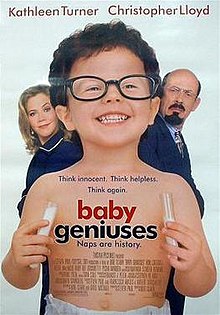Baby Geniuses
| Baby Geniuses | |
|---|---|

Theatrical release poster
|
|
| Directed by | Bob Clark |
| Produced by | Steven Paul |
| Screenplay by |
|
| Story by |
|
| Starring | |
| Music by | Paul Zaza |
| Cinematography | Stephen M. Katz |
| Edited by | Stan Cole |
|
Production
companies |
|
| Distributed by | TriStar Pictures |
|
Release date
|
|
|
Running time
|
95 minutes |
| Country | United States |
| Language | English |
| Budget | $12 million |
| Box office | $36.5 million |
Baby Geniuses is a 1999 American family comedy film directed by Bob Clark and written by Clark and Greg Michael based on a story by Clark, Steven Paul, Francisca Matos, and Robert Grasmere, and starring Kathleen Turner, Christopher Lloyd, Kim Cattrall, Peter MacNicol, and Ruby Dee.
The film has the distinction of being the first full-length feature to use computer-generated imagery for the synthesis of human visual speech. 2D warping techniques were used to digitally animate the mouth viseme shapes of the babies which were originally shot with their mouths closed. The viseme shapes were sampled from syllables uttered by the babies on the set.
The film grossed over $36 million worldwide. In 2004, it was followed by a sequel, Superbabies: Baby Geniuses 2. In 2011, an original series was announced. The series has so far aired in Italy and the Far East. Additionally, the series was released as a set of movies. Baby Geniuses and the Mystery of the Crown Jewels, which features episodes 1–4, was released directly to video in 2013. Episodes 5–8, Baby Geniuses and the Treasures of Egypt, came out in 2014, and episodes 9–12, were released as Baby Geniuses and the Space Baby in 2015. The series/movies follow the Baby Squad Investigators, or B.S.I., as they pursue Big Baby, his father Beauregard Burger (Andy Pandini), and the international thief Moriarty (Jon Voight).
Two scientists, Dr. Elena Kinder (Kathleen Turner) and Dr. Heep (Christopher Lloyd), use genius-baby studies to fund BabyCo's theme park "Joyworld". According to Dr. Kinder's research on toddlers/babies, babies are born possessing vast, universal knowledge and speak a secret yet impossible-to-translate baby pre-language called Babytalk. However, at age 2–3, the knowledge and language are lost as the babies cross over by learning how to speak human languages. Most of the babies raised in Dr. Kinder's underground research facility were adopted from the Pasadena City orphanage, transformed into little geniuses through use of the Kinder Method, and then used in experiments to decipher this secret yet impossible-to-translate language used by the 7 baby-geniuses.
...
Wikipedia
